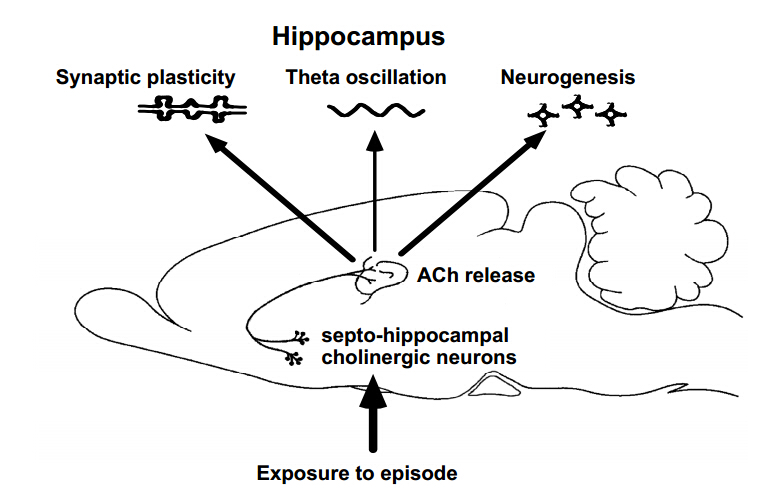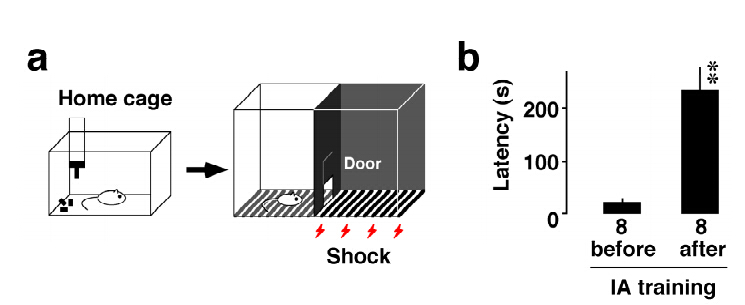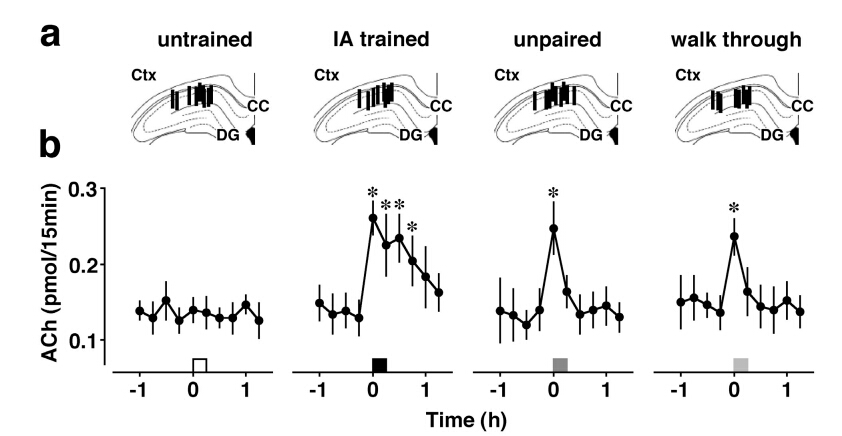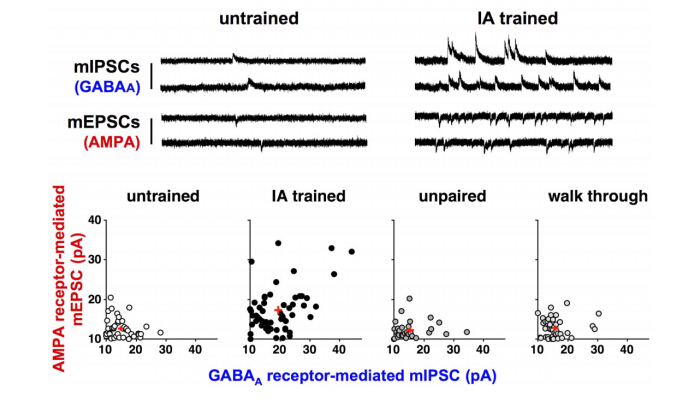1. Introduction
The hippocampus plays a central role to form new episodic memory in various species including humans [1]. The hippocampal neurons seem to process variety of information,such as spatial location [2],temporal information [3],and emotional state [4] within specific episodes [5]. However,the critical mechanism how to sustain a piece of specific memory or what associates the memory fragment each other is still largely unknown.
Since selective blockade of long-term potentiation(LTP)induction by NMDA receptor antagonist impairs hippocampal learning [6],LTP has been considered as a cellular model of hippocampal memory [7]. In 2006,in vivo field EPSC recording study showed that hippocampal learning induces LTP in CA1 region of hippocampus [8]. Further,we revealed that learning-dependent synaptic delivery of AMPA receptors into the CA3-CA1 synapses is required for hippocampal learning [9]. Since there is no tetanus electrode in brain,endogenous trigger and /or the mechanism inducing the learning-dependent LTP were unknown.
I hypothesized acetylcholine(ACh)as an endogenous trigger of LTP,since the ACh release in the hippocampus increases during learning or exploration. Moreover,without electrode for tetanus stimulation,bath treatment of ACh agonist not only induces specific bursts [10] but also forms LTP in CA1 region of hippocampal slices [11]. Based on the hypothesis,I found that i)cholinergic trigger drives learning-dependent synaptic plasticity at excitatory and inhibitory synapses,and ii)learning requires the diversity of synaptic inputs in CA1 pyramidal neurons [12].
ACh seems to be necessary to strengthen the information-specific tagged CA1 synapses [13],depicted by hippocampal-cortical networks [14].
2.Role of ACh in the hippocampus
A number of studies suggest that ACh plays an important role in orchestrating majorhippocampal functions(Figure 1). In behavioural studies,ACh release increases during learning [15,16,17] and is positively correlated with learning performance [18,19]. Bilateral injections of scopolamine into the dorsal hippocampus impair spatial learning ability [20],suggesting that muscarinic ACh receptors mediate the formation of spatial memory. At the network level,ACh generates a theta rhythm [21] that modulates the induction of long-term potentiation(LTP)in hippocampal CA1 neurons [22]. Studies exploring a genetic deficiency of muscarinic ACh receptors(M1 or M2)further show the impairment of LTP in the CA1 region [23,24]. At the cellular level,both pyramidal and non-pyramidal neurons in the hippocampal CA1 area receive direct cholinergic afferents mediated by muscarinic receptors [25,26,27]. In vitro studies showed that bath application of carbachol,a cholinergic agonist,induces LTP in CA1 pyramidal neurons without electrical stimulus,suggesting that ACh in the hippocampus plays a principal role in the synaptic plasticity of the CA1 pyramidal neurons [11]. Furthermore,a recent study revealed an intracellular mechanism of ACh: focal activation of muscarinic ACh receptors in one CA1 pyramidal neuron induces Ca2+ release from inositol 1,4,5-trisphosphate-sensitive stores to induce LTP [28].
ACh in the hippocampus not only enhances plasticity at CA1 synapses,but also contribute to adult neurogenesis in the dentate gyrus,that is required for contextual memory [29]. Neurotoxic lesions of forebrain cholinergic neurons or long-term scopolamine treatment decreases the number of newborn cells in the dentate gyrus [30,31].
3.Learning paradigm of episodic memory
Although it is well established that cholinergic inputs from the medial septum modulate learning and memory,evidence for the cholinergic regulation of learning-induced synaptic plasticity is lacking. To investigate learning-induced synaptic modification in the hippocampus,we used the IA task(Figure 2). In this paradigm,rats are allowed to cross from an illuminated box to a dark box where an electric foot shock is delivered. Thus,rats learn to avoid the dark box and stay in the lighted one,which they would normally not prefer [8,9]. The tendency to avoid the dark box therefore indicates the acquisition of contextual memories. The rats avoided entering the dark box when it was associated with a mild electric shock(IA-trained),but not those given foot shock without any contextual experience(unpaired),or those allowed to simply explore the experimental cage(walk-through). Untrained control rats were kept in their home cages and were not exposed to the IA apparatus.
4.Monitoring of in vivo ACh release
Cholinergic neurons within the basal forebrain provide the major projection to the neocortex and hippocampus [32]. Cortical regions receive cholinergic inputs mainly from the nucleus basalis magnocellularis(NBM)or the diagonal b and of Broca,whereas the hippocampus receivescholinergic inputs mostly from the medial septum and horizontal limb of the diagonal b and of
Broca [32]. Because the cholinergic projections are necessary to maintain learning and
memory [33,34],we hypothesized that in vivo monitoring of ACh release in the hippocampus is necessary to elucidate learning function. To measure ACh release,we have performed in vivo microdialysis studies in freely moving male rats. Briefly,a microdialysis probe with a semi-permeable membrane(0.5 mm in length)was inserted into a specific brain area via a surgically pre-implanted guide cannula. We perfused the inside of the membrane with artificial cerebrospinal fluid,and assayed ACh in dialysates using a high-performance liquid chromatography system. As a result,we observed long-lasting(≈60 min)ACh release in CA1 in IA-trained rats but not in untrained,unpaired,or walk-through controls(Figure 3)[12].
5.Contextual learning requires plasticity at CA1 synapses
Although it is well established that cholinergic inputs from the medial septum modulate learning and memory,evidence for the cholinergic regulation of learning-induced synaptic plasticity is lacking. By combining HSV-mediated in vivo gene delivery with in vitro patch-clamp recordings,we reported that contextual learning drives GluA1-containing AMPA receptors into hippocampal CA3-CA1 synapses. Double IA-training using two different contexts further drove AMPA receptors into the CA3-CA1 synapses [35]. More importantly,the synaptic delivery is required for contextual learning,since bilateral expression of AMPA receptor delivery blocker(MPR-DD)successfully impaired the contextual learning [9].
To further examine the learning-dependent synaptic plasticity,we recorded miniature EPSC(mEPSC at -60 mV) and miniature IPSC(mIPSC at 0 mV)from the same CA1 neuron under the presence of TTX(0.5 µM). Although control rats(untrained,unpaired,or walk through)show small mEPSC and mIPSC amplitudes,IA trained rats show significantly higher mEPSC and mIPSC amplitudes with much wider variation(Figure 4). These results suggest that each CA1 neuron has different excitatory or inhibitory synaptic inputs with wide electrophysiological variation.
Since I hypothesized that ACh is an intrinsic trigger of the synaptic plasticity,cholinergic receptor antagonist was microinjected into the CA1 neurons 15 min before the contextual learning. Microinjection of muscarinic M1 receptor antagonist(pirenzepine)into the CA1 successfully blocked the learning-dependent increase in mEPSC amplitude but not mIPSC amplitude. Conversely,microinjection of nicotinic a7receptor antagonist(methyllycaconitine)successfully blocked the learning-dependent increase in mIPSC amplitude but not mEPSC amplitude. In behaving rats,bilateral microinjections of pirenzepine or methyllycaconitine into CA1 successfully block the learning.
These results suggest that i)cholinergic trigger drives learning-dependent synaptic plasticity at excitatory and inhibitory synapses and ii)learning requires the diversity of synaptic inputs in CA1 pyramidal neurons [12]. Based on the results,I hypothesized that the diversity probably depicts cell-specific outputs processing experienced episodes after training(Figure 5). The mechanism of synaptic tagging at inhibitory synapses should be revealed in future.
6.Further findings and preliminary data
We recently monitored in vivo multiple-unit spike activity of CA1 neurons before,during,and after exposure to a strong episode using male rats. Although spontaneous firing rate was low in habituated home cage,spontaneous high frequency firing suddenly observed for seconds during or soon after the strong episode. Then,minutes after the episode,short term but high frequency ripple-like(on/off)synchronized firing was clearly observed and sustained [36]. These observations provide crucial evidence supporting our hypothesis of learning and memory(Figure 5).
To determine a possible location of contextual memory,we made acute brain slices in four different CA1 areas(dorsal right,dorsal left,ventral right and ventral left)in untrained or IA-trained rats. We found that IA training induced synaptic plasticity in both side of dorsal hippocampus,but not in ventral hippocampus [37]. Non-stationary noise-analysis techniques further revealed that IA training significantly increased the number of open channels in dorsal hippocampus,but not in ventral hippocampus. These results suggest that learning-dependent synaptic plasticity occur in dorsal hippocampus bilaterally,but not in ventral hippocampus [38]. Considering our previous study to block AMPA receptor delivery [9],encoded contextual information seems to locate in both side of dorsal hippocampus.
To determine whether the encoding of context or retrieval induces synaptic change,we made acute brain slices in 6 different timing after IA training. We found that i)the encoding of context rather than retrieval induces both excitatory and inhibitory synaptic change and ii)the encoding quickly induces the plastic change within 10 min after the training [39].
7.Hippocampal development requires ACh
We recently reported the developmental change in hippocampal ACh levels and contextual learning. Extracellular ACh levels in the dorsal hippocampus are low in juveniles,but increase significantly in adults. Simultaneous monitoring of ACh levels and spontaneous locomotor activity further demonstrated the development of ACh release. Although both juvenile and adult rats exhibited significant correlations between ACh levels and spontaneous activity,juveniles exhibited much more spontaneous activity than adults when they showed equivalent ACh levels. Similarly,low contextual learning performance in juveniles significantly increased,demonstrating a developmental trajectory of hippocampal function. In this report,we further revealed a developmental relationship between contextual learning and ACh level in the hippocampus [Freezing(sec)= 1171 ACh(pmol/20 min)+ 36].
More importantly,the ACh release in juveniles seems to be important to development of hippocampus and learning,since long-term treatment of scopolamine after weaning specifically impaired contextual learning without changing pain sensitivity,emotional state,and spontaneous activity. The findings,together with previous reports,lead to the hypothesis that juveniles require more spontaneous activity than adults to activate hippocampal functions. Our findings support the notion that every boy and girl requires sufficient spontaneous play in parks or nature to promote brain activity as well as physical activity [40].
8.Aging and Alzheimer's disease
In humans,aging seems to attenuate the ACh levels. Moreover,a reduction in ACh synthesis is known as a common feature of Alzheimer's disease [41,42,43]. The disease is the most common form of dementia [44] and is frequently accompanied by insomnia,poor concentration,and day night confusion [45,46]. The centrally active acetylcholinesterase inhibitor(donepezil)is effective in not only mild,but also moderate to severe cases [47,48],proving the importance of endogenous ACh in humans. We found neonatal sexual differentiation of the septo-hippocampal cholinergic system,suggesting sex-specific clinical strategies for Alzheimer’s disease [3]. Underst and ing the further detailed mechanism of ACh-triggered learning-dependent plasticity is essential for real improvements in therapy.
Conflict of Interest
I declare no conflicts of interest in this paper.










 DownLoad:
DownLoad: 










